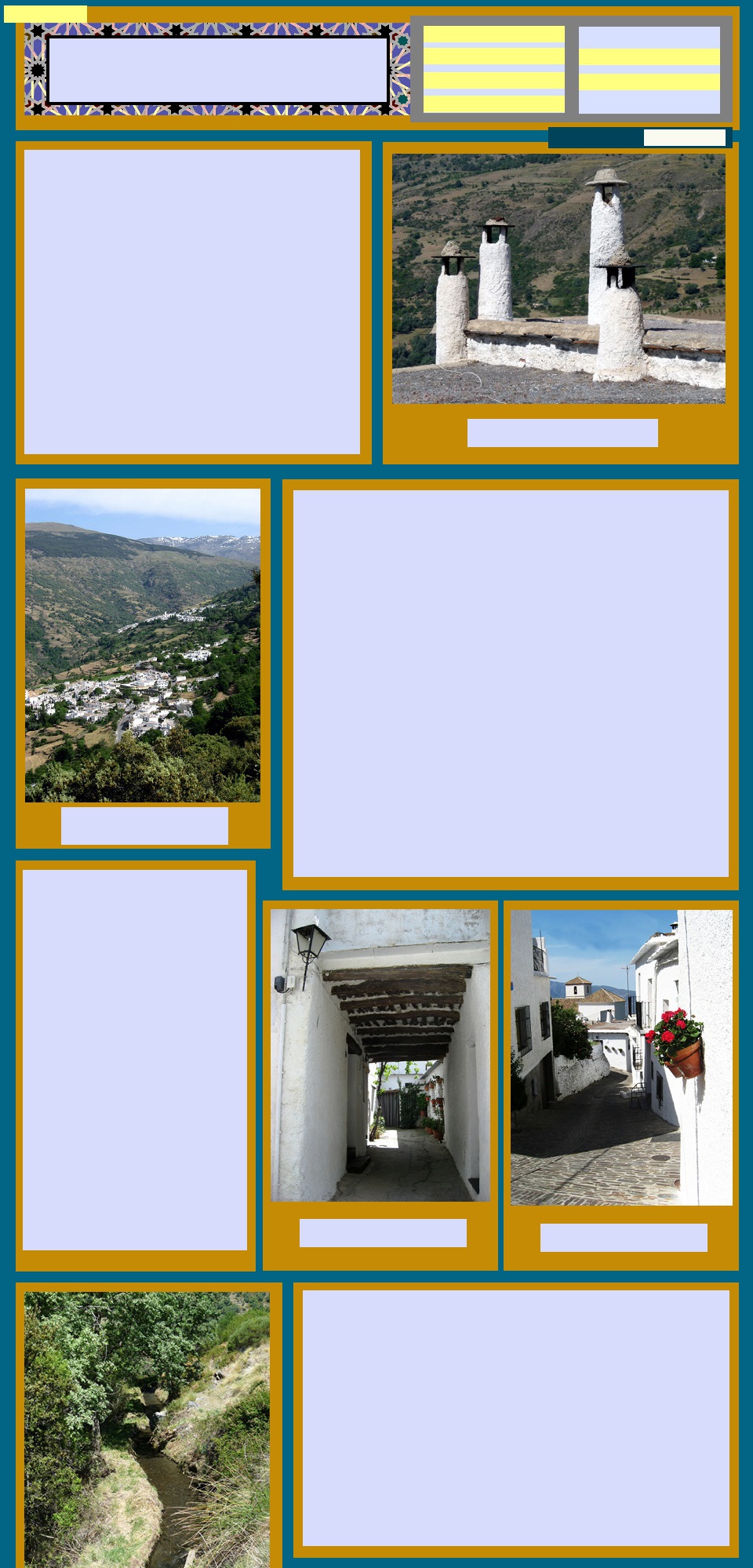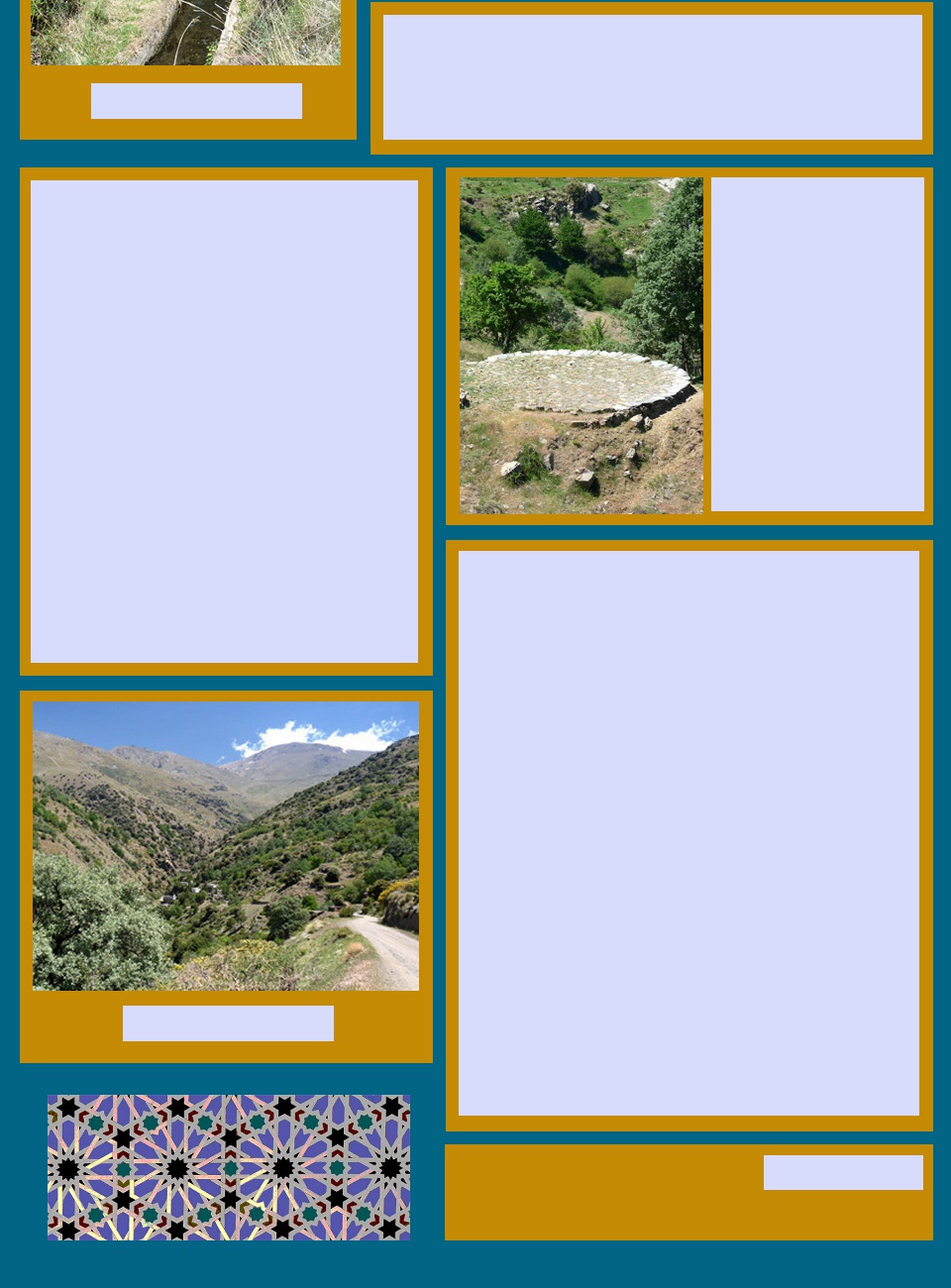Las Alpajurras
Andalucia
Las Alpajurras
From the terraces of the Alhambra in Granada you look towards the
snow capped peaks of Mulhacen (3479m) and Veleta (3395m) and
the other lofty summits of the Sierra Nevada. Just south of these
peaks is the region known as Las Alpujarras or La Alpujarra. This is
an area of ridges and valleys, criss-crossed with a network of mule
paths, irrigation channels, hiking routes and, once again, brilliant
white villages.
Developed first by the Romans, in Moorish times the region was
densely populated and abundant with vines and orchards.
It was the final refuge of the Moors after their expulsion from
Granada in 1492. For nearly 150 years, as Moriscos (converts to
Christianity), they were allowed, to an extent, to maintain their own
distinct culture in this isolated mountain area. But there was always
unrest between the Moriscos and the Catholic monarchs until
finally, in 1568, a rebellion was ruthlessly crushed and all people of
Arab descent were evicted from the region and dispersed.
The villages were resettled with some 12,000 Christian families
brought by King Philip II from Galicia and Asturias in north-western
Spain. These settlers found the harsh environment very difficult
and the economy of the Alpujarras was seriously damaged for
years to come.
Fortunately the villages retained their traditional Berber architecture - terraced clusters of
white box-shaped houses with flat clay roofs, a style which is still common in the Rif
and Atlas mountains of Morocco. Perhaps the most picturesque villages are
Pampaniera, Bubión and Capiliera which snuggle, one above the other, into the hillside
of the Poquiera valley.
We were immediately attracted to a traditional village house in Bubión in our search for a
base in Las Alpujarras. It looked gorgeous and suited our needs so well that we shrugged
off the comment that it was "at the base of the village". On our arrival we discovered that
the house was indeed at the lowest point of the village, reached on foot by a series of
ridiculously steep narrow streets that could not be negotiated by vehicles. As any walk in
this area involves considerable uphill climbing, this proved to be very good training. With
our car left at the top of the village we had to take care not to forget anything when we
went shopping or out for the day so as to avoid unnecessary ascents to the village.
Bubión is the middle of the three Poquiera villages. It sits at 1350 m, and has a
permanent population of about 350, swelling to considerably more when all the houses
available for rent are filled. It has exceptional views, to the snow capped mountains and,
so they say, the Mediterranean. Unfortunately it was never clear enough during our stay
for the sea to be visible.
Its Moorish origins are clearly seen in the classic architecture, houses built on top of
each other and spilling down the steep mountainside. Nearly every house has a
colourful display of pot plants and often little vegetable gardens watered from the
ancient irrigation channels.
There was a very good restaurant called El Teide with a lovely garden where we enjoyed
drinks and tapas sitting in the deep shade of cherry trees. Given that there was only a
small sparsely stocked supermarket in the village, we indulged in a few meals there as
well. There were several other bars and cafes and some shops selling rustic rag rugs and
a variety of mountain products like jam, honey and quite drinkable wine that was sold in
bulk.
The architecture
The picturesque buildings of the Alpujarras
are one of the most typical features of the
landscape. The whitewashed cubic houses
are built against the slopes, one above the
other, with flat roofs and cone shaped
chimneys.
The houses usually have two floors. The
lower level was originally for livestock and
farm tools and now accommodates the
kitchen and dining area. Upstairs are the
bedrooms and living rooms and often a
terrace.
Traditionally the roofing is made of a
magnesium clay that is impermeable to rain
and above that is a layer of stone. On the
inside, an exposed layer of flat stones forms
the ceiling, kept in place by beams of
timber. Sitting on top of the flat roof are the
cute little chimneys, all different, and
seeming to dance around the rooftops,
talking to each other.
Sometimes a sort of bridge, known as a
tinao spans the narrow village street between
the houses on either side and enclosing the
street into a narrow passageway.
The irrigation system (Acequias)
Acequias, from the Arabic as-saqiyya (saqaa is to quench one's thirst), are the canals
that slope along the sides of the mountains carrying the reliable supply of water from
snowmelt of the Sierra Nevada to the villages and smallholdings in the valleys.
Originally cut by the Romans but massively extended by the Moors, they are what
turned this valley from a wild, semi-barren string of crags into fertile terraced hillsides.
When the Moors were expelled the Spanish crown ordered that two Moorish families
were to remain in each village in order to demonstrate to the new inhabitants the
workings of the systems on which the district's agriculture depends
It is an intricate and highly organised system. According to a preset timetable, water
is diverted from the channels through a system of sluice gates, sometimes crudely
blocked with stones and rags, onto the cultivated terraces or village gardens. Chris
Stewart, in his book Driving over Lemons, gives an amusing account of the communal
effort required to maintain the channels and the way in which timeslots for the flow of
water are allocated. As the newcomer to the area he was allocated a time in the early
hours of the morning to climb up the hills, divert the water onto his farm for the
allowed period and then block the outlets to let the water continue on its course.
Our house in Bubión was very typical of the traditional style. Gleaming white, it was on
two levels, built into the hillside and abutting the next door house. On the top level were
the bedrooms, a huge comfortable living room and a lovely terrace that looked out across
the terraced hills and down to Pampaniera, the next village. It was very well equipped,
beautifully decorated and furnished with antique furniture. We were delighted that the
owner trusted paying guests sufficiently to leave many tasteful bits and pieces to add to
the character of the house.
There are a number of traditional
threshing floors (eras) in the
Alpajurras. These are now
abandoned due to depopulation
of the area and to changes to
agriculture. They serve as
reminders of the hard life
endured by the farmers of the
Alpajurras before modernisation.
This particular one is near
Capillera and is sometimes used
as a stage for concerts in
summer.
There were gardens on several levels and alongside the house
was a concrete channel that we were to discover was part of
the village system of acequias. On our arrival there was just a
trickle of water seeming to have seeped out of the hillside, but
several nights later we were woken by the thundering roar of
gushing water cascading down the hill. It continued for several
hours and then stopped, presumably having been diverted into
the gardens of the village and then continuing down to the
farmland below. It was to be intermittently turned on and off
during our entire stay.
The opportunities for walking in this area are bountiful though
all involve some steep uphill exertion. The ubiquitous GR 7 ran
right through the village and there were many local routes and
pathways, way marked in their different styles and colours. It
has to be said that at times this was quite confusing, as the
signage and the available printed guides often gave different
and conflicting information. You got to the same place but
maybe not in the way you expected.
Part of the attraction of Bubión was the opportunity to start
with short walks to the villages of Pampaniera and Capiliera.
Pampaniera is reached by dropping nearly 300m, good on the
way down, hard on the way back but there are better shops
there and a small fresh fruit and vegetable stand in the main
village square. Capiliera, the highest of the villages is higher by
about 100 m according to the map but the pathway goes right
down to the river, only to climb up again to the village. Happily
there are very good restaurants there to make the climb
worthwhile.
From Capiliera there is more serious walking. Roads and tracks descend
to the Poqueira River, a clear little stream which rushes downhill through a
deep gorge. Rustic bridges cross the river from time to time and, judging
from the warning signs along the track, are occasionally swept away.
Alongside the tracks are terraced hillsides and abandoned farmhouses
and sometimes curious circular threshing pads, dating from the times
when this was an intensively farmed valley.
Some of the trails follow the acequias and you get a real appreciation of
the clever engineering that distributes the water through channels, into
pipes and through sluice gates into downhill flows. Another amusing
feature along these routes is the use of old bed frames as fences and
gates - a very sensible use of an otherwise disposable item.
Climbing up from the river, Mulhacen, Andalucia's highest peak, towers
on the skyline. On its lower slopes, the Refugio del Poqueira is a popular
target for walkers. Up in the high peaks of the Sierra Nevada there are
many short and long distance options including the popular Sierra Nevada
Traverse a strenuous, but rewarding, experience. This route starts further
east in Trevelez and, after three days walking, takes you down to
Lanjaron.
Crossing Las Alpajurras from west to east is our old friend the GR7.
There are lots of options to pick it up for a day and either retrace your
steps, find another track back or catch a bus back to base. On one of our
walking days we picked it up it Bubión, climbed to the high point of our
valley and carried on to Capilerilla and Pitres. After lunch in Pitres we
retraced our steps to Bubión, finding an alternative way back down to the
village and the very welcome terrace of El Teide.
We really only scratched the surface of the walking opportunities in the
area. There is another group of villages called la Tahá near the town of
Pitres. More white villages, more heroic climbs and more beautiful
mountain scenery. But this pocket, like so much else in Andalucia, will
have to wait for another trip.
The remarkable chimneys of Bubión
View of Bubión, Capillera and
the Sierras
Street with tinao in Bubión
Street in Bubión
Water channel acequia, Capillera
Up the Poquiera Valley
View pictures of


